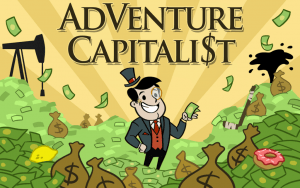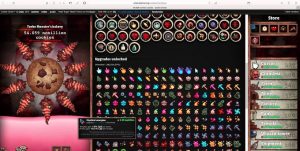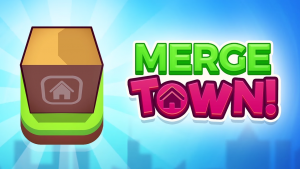Las 7 mejores mecánicas de juego inactivo
El género de juegos inactivos se ha ido calentando rápidamente en dispositivos móviles. Lo que alguna vez fue un pequeño nicho independiente se ha expandido rápidamente en los últimos años. Entonces, ¿cómo puede usted, como desarrollador, aprovechar esta tendencia? ¿Cómo se puede crear la próxima idea de juego inactivo que dominará el mercado?
Esta es una continuación de nuestro artículo Las 10 mejores mecánicas de juego para juegos hipercasuales que también te puede gustar.
Las mecánicas de juego inactivas no son nada nuevo. Anthony Pecorella de Kongregate profundizó en la tendencia en GDC 2015, pero a medida que avanzamos en 2019 estamos viendo algunos avances en la tendencia.
Recuerdo haber jugado Cookie Clicker , Adventure Capitalist , Tap Titans y las montañas de clones del simple juego inactivo llegaron en 2014, pero luego la tendencia desapareció. Sin embargo, algo cambió. A partir de 2016, hemos visto un gran resurgimiento del género de juegos inactivos para dispositivos móviles:
Descargas agregadas y crecimiento de ingresos para el género de juegos inactivos para dispositivos móviles desde el tercer trimestre de 2016 hasta el segundo trimestre de 2018 Fuente: Sensor Tower Estimates
Si analizamos los juegos inactivos de 2014 a 2018, podemos ver una tendencia creciente tanto en las descargas como en los ingresos de este género. Este no es el caso de la mayoría de los géneros para adultos en dispositivos móviles. Rompecabezas, Simulación, Casino y Estrategia se han estabilizado o disminuido en descargas y han experimentado un lento crecimiento en los ingresos. Estos géneros están bloqueados, pero Idle sigue siendo un foco de innovación en el mercado móvil.
En los últimos años hemos visto muchos estilos completamente nuevos de mecánicas de juegos inactivos llegar al mercado y tener éxito: Merge Town de Gram Games desafió la suposición de que los juegos inactivos eran sólo para matemáticos expertos en hojas de cálculo, Trailer Park Boys de East Side Games muestra un camino en el que los juegos inactivos pueden albergar una narrativa convincente, y Idle Miner de Kolibri (anteriormente Fluffy Fairy) muestra que los juegos inactivos pueden crear bucles de juego convincentes al estilo de simulación tradicional.
Para esta publicación, me gustaría mostrar la variedad de caminos hacia el éxito que puede tener un juego inactivo. Si bien esto puede centrarse únicamente en el pasado, la esperanza es que pueda inspirarte a crear mejores ideas de juegos inactivos para el futuro.
¿Qué es inactivo? ¿como funciona?
Si ha estado viviendo bajo una roca y no entiende qué es la inactividad, lo hemos cubierto varias veces: (somos fanáticos aquí en MFTP)
 Lectura relacionadaJuegos inactivos, ¡todo lo que necesitas saber!
Lectura relacionadaJuegos inactivos, ¡todo lo que necesitas saber!
Los juegos inactivos han aumentado en los dispositivos móviles porque es un género perfecto para el diseño gratuito de dispositivos móviles modernos. La mecánica de los juegos inactivos crea sesiones móviles perfectas e impulsa una fuerte retención a largo plazo.
 Lectura relacionadaPor qué deberías preocuparte por los juegos inactivosIn Retention, DesignAdam Telfer
Lectura relacionadaPor qué deberías preocuparte por los juegos inactivosIn Retention, DesignAdam Telfer
Idle games, sometimes called Clicker or Incremental games, are games which are all about management of income. Similar to simulation games, their main differentiator is the focus on revenue growth decisions. For some examples: Idle Games on Kongregate / Reddit’s Guide to Idle Games
The key to the genre: no matter what you choose, you will make progress. But optimizing your decision about what upgrades to purchase next is the core of the strategy and what drives long-term interest in the genre. Because the core of the game is focused on long-term purchasing decisions, retention is built in. Because progress is always felt, it always feels rewarding to come back.
Let’s now dive into the variety of mechanics within the idle genre.
#1 Linear/Clicker Idle
The core of these games are usually insanely simple: tap as fast as you can to generate income. This starts off as fun, but gets pretty tiring and uninteresting quickly. So it quickly shifts into deciding over which upgrades to spend that cash on:
- Do you want to generate more money while you’re away?
- Do you want to generate more income from your own taps?
- Do you want to save up for the big purchase that will increase your income tenfold?
- Or continue to purchase cheap upgrades for small income gains?
This decision-making structure has stuck with idle, but the core gameplay of tapping as fast as you can has not.
Over time, developers tried changes to the core gameplay to make it last a bit longer: Make it Rain! and Farm Away used swipe controls instead of tap to make it more mobile friendly. However, the core mechanic always quickly became a bore, and the appeal of just swiping or tapping as fast as you can to progress is only appealing to some.
Also, due to the nature of the game, prestige mechanics became a necessity. Pushing the player to reset their progress back to the beginning in order to make the growth more manageable and ensure the player still felt growth in the slower endgame. This was never all that appealing to players — so developers had to find clever ways to sidestep the issue and incentivize the full reset.
It’s important to note that this style of game has gone out of fashion. Besides Partymasters (pictured), there haven’t been many successful new titles that only use clicker gameplay or similar. The resurgence of the genre has actually been on taking the progression mechanics learned in this genre and applying it to whole new mechanics, whole new audiences.
#2 Arcade Idle
So what do you do when clicking style gameplay is uninteresting? Take the same progression system mechanics you know work well, and graft it onto more compelling core gameplay. Enter Voodoo, who mastered this approach throughout 2017 and early 2018.
 Related ReadEverything you want to know about Voodoo – An Interview with Voodoo GamesIn Growth Marketing, Industry Market TrendsTom Kinniburgh
Related ReadEverything you want to know about Voodoo – An Interview with Voodoo GamesIn Growth Marketing, Industry Market TrendsTom Kinniburgh
Instead of asking the player to tap to earn their coins, Voodoo asked them to play simple arcade games that have mass appeal. Games like “Idle Invaders” used classic shoot-em-up gameplay (ex. Space Invaders, 1942) to earn their income manually. Shoot down incoming invaders as fast as you can to earn your manual income, and then purchase and upgrade computer-controlled allied fighters to fight alongside you. This made for a compelling formula, that was easily replicated across multiple genres. “Idle Sweeper” took Pac-Man, “Idle Flipper” took flipping style gameplay.
Any simple arcade gameplay which had an opportunity for scaling health/damage and computer-controlled assists could create a compelling new idle game.
Planet Bomber was the first to expand on this formula, adding more depth to the game by adding more types of upgrades. Before, games would offer linear upgrades to damage dealt, or income generated. Planet Bomber now offers upgrades across a number of parallel vectors, all with a variety of importance to the core gameplay. This creates a far more compelling long term strategy, and is what future idle games will need to focus on. How do you find core gameplay that can offer a variety of upgrades that are equally visible and impactful to progress?
#3 Merge Idle
The merge mechanic was first pioneered by games like Triple Town, but turned commercially successful by Gram with Merge Dragons and Merge Town.
 Related ReadDeconstructing Merge Town: The Rise of Hyper CasualIn Deconstructions, MonetizationAdam Telfer
Related ReadDeconstructing Merge Town: The Rise of Hyper CasualIn Deconstructions, MonetizationAdam Telfer
Merge style games take out the tiring clicker gameplay and swap it for merging items: drag and drop duplicate items on top of each other to increase their level. What’s a simple premise turns into an addicting experience, because the game always feels like there is something to do. Sessions are impressively long because it’s just so compelling to constantly build up your houses towards the next goal. The next goal is so clear (I want to upgrade my best house), and the path is clear (merge until I get a duplicate) — yet as soon as I complete a goal, I’m compelled to start the next path.
What Merge Town did more than just increase the session length was bring in an entirely different audience. No longer are idle games just about increasing numbers, but giving clear visual progress. This type of gameplay is for a much broader audience than most idle games, yet kept all the engagement mechanics intact.
#4 Idle Simulation
Simulation has been on the decline on mobile for years, with Sim City Build It and Fallout Shelter (arguably) being the last big games in the space. Yet on Idle, in the last year we’ve seen a new face of simulation games: Idle Simulation. Wheras Sim City Build It, Farmville, Hay Day may appeal to a older, broader demographic, Kolibri’s “Idle Miner Tycoon” and “Idle Factory Tycoon” have shown a compelling business case for using classic simulation game loops.
Unlike the previous idle game mechanics, idle simulation games don’t innovate in the core gameplay. In fact, with Idle Miner and Idle Factory — they remove a core mechanic altogether. Tapping fast no longer helps you — the game stays compelling by asking you only to be managing your upgrades, and managing what boosters to start. This used to be an issue for idle games — since idle games typically had to start slow and progress quickly in order to give you a sense of progress, tapping gameplay was an easy out for designers to give a player something to do between upgrades. With simulation games, the upgrades are fast, but also far more strategic. As such, it doesn’t need tapping style gameplay as a crutch.
These games rely on a traditional simulation game loop, similar to compulsion loops you felt in games like Sim City (the original) and Roller Coaster Tycoon. Purchasing one upgrade will strain another system. In Idle Miner, purchasing an upgrade for a mine will mean that mine generates more income per second. This puts a strain on your elevator — the elevator then needs to be upgraded in order to hold on to more resources. Upgrading that elevator will put a strain on your surface level extraction… This goes round and round straining each system giving you new goals with each step and avoiding upgrades feeling stale.
Idle Miner and Idle Factory aren’t the only games that have attempted this and succeeded. I’d recommend playing Crafting Idle Clicker, Reactor Idle, and Factory Idle on Kongregate. This genre has seen the biggest surge in downloads, and there is plenty of room for innovation to come. This is the category to watch for new developers.
#5 Idle Management
One mechanic that hasn’t been done often on mobile, but more often on Kongregate is more “Management” style sims. Check out a game called “Groundhog Life”: this is a life management simulator, with obvious idle characteristics.
The core gameplay is replaced with choosing which system to boost. In Groundhog Life, you can choose how you want to spend your 24 hours each day: spend 8 hours or 2 hours sleeping? Spend more time at work, or studying? While your character is always making progress, whether they are progressing in learning a new skill, earning money, or being happy is down to the decisions you make. Each time you die, you pass on your traits to your next life — giving you a boost depending on your choices in the previous life. While there haven’t been many mobile idle games that have used this mechanic, this is by far the most addictive idle game that I’ve ever played.
#6 Story-driven Idle
Going in a different direction, there’s also innovation happening in how idle games have made prestige (resetting your progress) less punishing and more relevant. Trailer Park Boys: Greasy Money by East Side games is a masterclass in this. Many developers have attempted to graft licensed IP onto idle games, but none fit so well as Trailer Park Boys — in the last episode of every TV season, they end up in jail losing everything. East Side baked this into the game design: at the end of each season of generating a ton of cash from idle systems, the boys are caught by the cops and you lose all your money.
 Related ReadDesigner Diary – Trailer Park Boys: Greasy MoneyIn Design, DeconstructionsDave Rohrl
Related ReadDesigner Diary – Trailer Park Boys: Greasy MoneyIn Design, DeconstructionsDave Rohrl
This creates a strong narrative arc in the game that makes sense in the idle game loop. Each prestige (which happens more often), the player gets a drip of story. This creates a more interesting long-term goal for the player besides just increasing their numbers.
The game has been a breakout success for East Side Games, and it’s why they’ve been slowly bringing on more licensed IP to work with. Their current game, “The Gang Goes Mobile” based on It’s Always Sunny in Philadelphia is currently in soft launch.
#7 Idle RPG
Lastly, is most likely the biggest in-app purchase revenue generating idle category: RPG.
Clicker Heroes and Tap Titans were arguably the first games in the genre — showing that you can add battle mechanics with an idle progression, but both games actually fit more into category #1 based on their real mechanics. RPG can offer more than just a facade for progress.
Non-stop Knight fue el primero en irrumpir en este espacio, al agregar un juego de rol automático como núcleo, mientras le pedía al jugador que eligiera cuándo usar sus potenciadores. En lugar de actualizaciones lineales, el personaje comenzó a recolectar botín de caídas aleatorias (gracias Diablo), recolectar mascotas y desbloquear nuevos aumentos. Knight sin parar fue revolucionario en su época, pero en retrospectiva se apoyó demasiado en la progresión ociosa como para crear un ciclo de compromiso convincente a largo plazo.
El rey de Idle RPG es sin duda Idle Heroes . En lugar de centrarse demasiado en Idle Progression, tomaron muchos de los sistemas de progresión de Heroes' Charge y Galaxy of Heroes . Se centra más en un sistema de progresión infundido con gacha: reúne un equipo de héroes, equípalos con el mejor equipo posible y compite en eventos de tiempo limitado por las monedas que necesitas desesperadamente.
Este nivel de complejidad es probablemente el siguiente paso para los juegos Idle RPG. Manteniendo el juego central simple y convincente, pero creando más estrategia en la forma de crear y administrar un equipo de héroes, y construyendo sobre una economía cuyos eventos son necesarios para ser competitivo .
En resumen
Como puede ver, las mecánicas de juego inactivo admiten una amplia variedad de diseños de juego. No asumas simplemente que el juego de clicker probado es la única opción cuando se te ocurren ideas de juegos inactivos.
Idle, a diferencia de la mayoría de los géneros en dispositivos móviles, tiene mucho espacio para la innovación. Ha creado casos de negocio convincentes para muchas empresas exitosas de juegos móviles y, como género, tiene mucho espacio para que entren los recién llegados. Como diseñador en este espacio, echaría un vistazo a lo que se ha hecho y predeciría lo que sucederá en el futuro:
- No te quedes con el juego principal tradicional : encuentra nuevos juegos principales que te permitirán llegar a nuevas audiencias como Merge Town e Idle Invaders.
- Añade más estrategia a la progresión : crea bucles de juego atractivos utilizando estadísticas de actualización que realmente se apoyan entre sí. Comprar una actualización en un área lo impulsará a actualizar en otra.
- El mercado está madurando rápidamente : no subestime el valor de la propiedad intelectual con licencia o la creación de un marco de eventos para sus operaciones en vivo .
Si tiene esto en cuenta, mi esperanza es que el mercado inactivo continúe innovando en los años venideros.

Leave a Reply